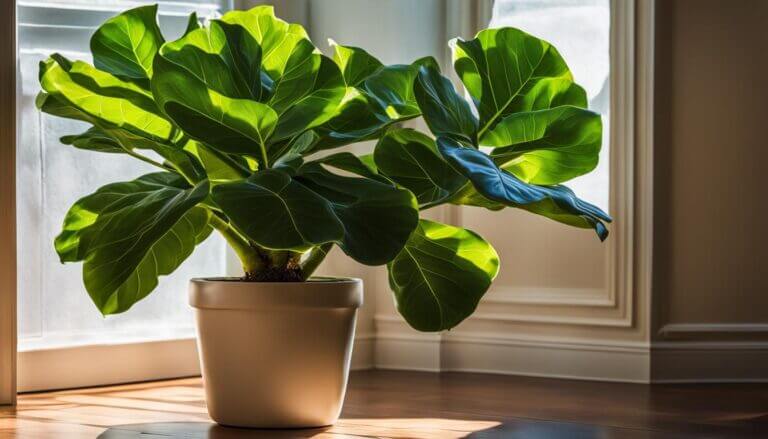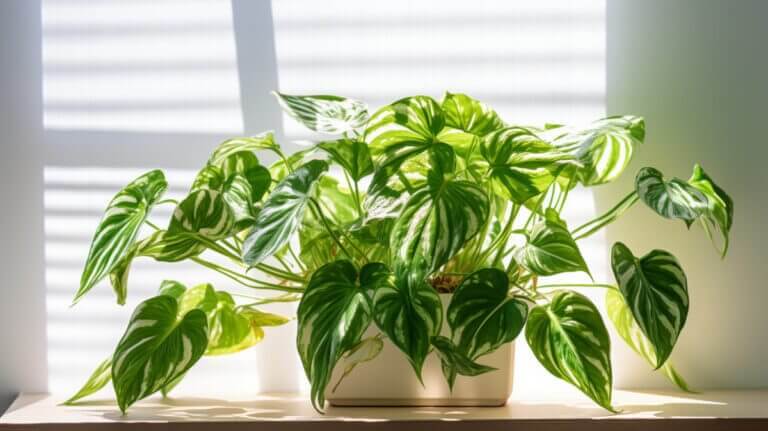Welcome to my beginner’s guide on growing croton houseplants! If you’re looking to add a touch of tropical beauty to your indoor space, crotons are the perfect choice. These vibrant and colorful plants, scientifically known as Codiaeum variegatum, boast stunning foliage in shades of green, yellow, orange, red, and even purple. In this guide, I’ll provide you with all the information you need to successfully care for croton plants, from light and water requirements to temperature considerations and pruning tips. So let’s dive in and discover how to unleash your inner greenthumb with croton houseplants!
Key Takeaways:
- Growing croton houseplants is a great way to add vibrant foliage and a tropical touch to your indoor space.
- Crotons, scientifically known as Codiaeum variegatum, are known for their colorful leaves in various shades.
- Provide your croton with bright, indirect light for optimal growth. Avoid placing them in direct sunlight to prevent leaf scorching.
- Maintain moist soil and high humidity levels for your croton plants to thrive. Use methods like tray-filled water and pebbles or a humidifier.
- Keep your croton away from drafty areas and provide them with a stable temperature between 60°F and 80°F for optimal health.
Understanding Croton Plants
Croton plants, scientifically known as Codiaeum variegatum, belong to the family Euphorbiaceae. They are commonly referred to as variegated laurel, rushfoil, or simply croton. What makes crotons stand out is their vibrant and colorful foliage, which features a variety of shades including green, yellow, orange, red, and even purple. Crotons can come in different varieties, each with its own unique leaf patterns and colors. These tropical plants are known for their ability to change form over time, growing from a dense shrub to a tree-like sculptural form. Popular croton varieties include Picasso’s Paintbrush and pictum, which have delicate feather-like foliage. It’s important to note that crotons can be poisonous if ingested, so caution should be exercised if you have pets or small children.
With their vibrant foliage and tropical charm, croton plants make a stunning addition to any indoor space. Their eye-catching leaves add a pop of color and bring a touch of nature into your home. Whether you’re a seasoned plant lover or just starting your indoor gardening journey, understanding the unique characteristics of croton plants is essential for their well-being and successful growth.
One of the distinguishing features of croton plants is their variegated foliage, which is characterized by its rich and vibrant colors. The leaves of croton plants can display a stunning range of hues, including shades of green, yellow, orange, red, and even purple. These colorful leaves make crotons a popular choice for those looking to add a tropical touch to their indoor spaces.
In addition to their vibrant foliage, crotons are also known for their ability to change form as they grow. While they start as dense shrubs, over time, they can develop into tree-like forms, with sculptural branches and dramatic leaf arrangements. This growth pattern adds to the visual appeal of crotons and makes them a unique and fascinating plant to care for.
| Croton Variety | Leaf Pattern | Colors |
|---|---|---|
| Picasso’s Paintbrush | Feather-like | Green, yellow, red |
| Pictum | Delicate and serrated | Green, orange, yellow |
| Gold Dust | Speckled | Green, yellow |
Croton plants are also known for their toxicity. The sap of the plant can be mildly toxic if ingested, so it’s important to keep them away from pets and small children who may be tempted to chew on the leaves or stems. If you have pets or young children in your home, it’s advisable to place your croton plants in areas where they can’t be reached or consider choosing non-toxic houseplants instead.
Overall, croton plants are a beautiful and captivating addition to any indoor space. Their vibrant foliage, unique growth patterns, and variety of leaf colors make them a popular choice among plant enthusiasts. By understanding the characteristics of croton plants and providing them with the right care, you can enjoy their beauty and vibrant colors for years to come.
Light Requirements for Croton Plants
Proper lighting is crucial for the healthy growth and vibrant colors of croton plants. These tropical beauties thrive in bright light, making them perfect for well-lit indoor spaces. To ensure your croton plant receives the right amount of light, it is recommended to provide a minimum of five hours of direct sunlight each day. However, keep in mind that too much direct sunlight can lead to leaf scorching.
Crotons also do well in indirect light, so placing them near a window with filtered sunlight, such as an eastern, southern, or western exposure, is ideal. If you notice your croton’s leaves losing their vibrancy, it may be a sign that they are not receiving enough light. In such cases, adjusting the location of your plant to a brighter spot can help restore its color and promote healthy growth.
| Light Requirements | Sunlight Exposure |
|---|---|
| Bright Light | Minimum of 5 hours of direct sunlight per day |
| Indirect Light | Filtered sunlight from eastern, southern, or western exposure |
It’s important to note that crotons can also be grown under artificial lights indoors. Using full-spectrum fluorescent lights or LED grow lights can provide the necessary light intensity for croton plants. Remember to adjust the distance between the lights and the plant to prevent burning or damage to the leaves.
In summary, bright and indirect light are the key to keeping your croton plants happy and thriving. Whether you choose to place them near a window or use artificial lighting, providing adequate light will ensure your crotons showcase their stunning foliage to the fullest.
Watering and Humidity for Croton Plants
Proper watering and humidity levels are crucial for the health and well-being of your indoor croton plants. Understanding the specific moisture requirements and humidity preferences will help you create the ideal environment for your vibrant foliage. Let’s explore the best practices for watering and maintaining humidity for your croton plants.
Watering Croton Plants
Croton plants prefer to be kept consistently moist, but it’s important not to overwater them. Allow the top inch of soil to dry out between waterings to prevent root rot. To check if your croton needs watering, insert your finger into the soil. If it feels dry at a depth of about an inch, it’s time to water. Avoid letting the soil become bone dry or waterlogged.
When watering your croton, give it a thorough soak until water drains out of the bottom of the pot. This helps remove any salt build-up from fertilizers. Remember to use room temperature water to prevent shocking the plant. During the growing season, which is typically spring and summer, you may need to water your croton more frequently due to increased evaporation. In the fall and winter, reduce watering frequency as the plant enters a dormant phase.
Maintaining Humidity for Croton Plants
Croton plants thrive in high humidity levels. Aim to maintain a humidity level of around 60% throughout the year. This can be achieved through various methods:
- Placing a humidifier near your croton plant to add moisture to the air.
- Creating a humidity tray by placing your croton on a tray filled with water and pebbles. As the water evaporates, it increases the humidity around the plant.
- Grouping your croton with other plants to create a microclimate with increased humidity.
Misting the leaves of your croton plant can provide temporary relief and increase humidity. However, misting alone is not sufficient for long-term humidity control. It’s important to note that excessively dry air can lead to leaf browning and dropping. Regularly monitor the humidity levels around your croton and adjust the humidity-inducing methods as necessary.
Summary:
Proper watering and humidity are essential for the health of your croton plants. Keep the soil consistently moist, but not overly saturated, allowing the top inch of soil to dry out between waterings. Aim to maintain a humidity level of around 60% by using a humidifier, humidity trays, or grouping your croton with other plants. Misting the leaves can provide temporary relief, but it should not be relied upon solely to increase humidity. By providing adequate moisture and humidity, you can ensure your croton plants thrive and display their vibrant foliage.
Temperature Considerations for Croton Plants
Croton plants are sensitive to temperature and require specific conditions to thrive. Understanding the temperature requirements for your croton plants is crucial for their overall health and well-being. Let’s explore the ideal temperature range, the impact of drafty areas, and how to adjust care routines based on the season.
Temperature Range
Croton plants prefer temperatures between 60°F and 80°F (15°C to 27°C). This range provides the optimal conditions for their growth and development. Keeping your crotons within this temperature range will ensure that they receive the warmth they need while avoiding any extreme heat or cold.
Cold-Sensitive Crotons
Crotons are sensitive to cold temperatures and should be protected from drafty areas. Exposure to cold drafts, such as windows or doors, can cause stress and lead to leaf damage. It’s important to keep your croton plants away from these areas to prevent any adverse effects.
Adjusting Care for the Seasons
During the growing season, which typically occurs in spring and summer, crotons thrive in warm and humid conditions. It’s important to provide them with the right temperature and humidity levels during this time to support their growth. As fall and winter approach, temperatures drop, and the care routine needs to be adjusted accordingly. Reduce watering and avoid exposing your croton plants to cold drafts to prevent stress and leaf damage.
| Season | Temperature | Care Tips |
|---|---|---|
| Spring and Summer | 60°F to 80°F (15°C to 27°C) | Provide warm and humid conditions. Water regularly to maintain moisture levels. |
| Fall and Winter | Below 60°F (Below 15°C) | Reduce watering. Protect plants from cold drafts. Adjust care routine to accommodate lower temperatures. |
By ensuring that your croton plants are kept within the recommended temperature range and adjusting their care routine based on the seasons, you can promote their health and encourage vibrant growth. Remember to always observe your plants and make any necessary adjustments to optimize their growing conditions.
Fertilizing and Pruning Croton Plants
Proper fertilizing and pruning are essential for maintaining the health and appearance of your croton plants. Fertilization provides the necessary nutrients for new growth and vibrant foliage, while pruning helps maintain a compact and bushy shape. Here are some tips and guidelines for fertilizing and pruning your croton plants:
Fertilizing:
- Use a balanced liquid fertilizer specifically formulated for indoor plants.
- During the growing season, which is typically spring and summer, feed your croton every 4-6 weeks.
- Dilute the fertilizer to half strength to avoid overfeeding, which can lead to burnt leaves.
- Apply the fertilizer to moist soil, ensuring thorough coverage.
- Monitor the plant’s response to fertilization and adjust the feeding schedule if needed.
Pruning:
- Regularly remove any dead or yellowing leaves to maintain the overall health of the plant.
- Prune leggy stems to encourage a bushier appearance and promote new growth.
- Use clean, sharp pruning shears or scissors to avoid spreading diseases.
- Wear gloves when pruning as croton sap can be mildly toxic and may irritate the skin.
- Dispose of pruned foliage properly to prevent the spread of pests or diseases.
By following a proper fertilizing and pruning routine, you can ensure that your croton plants remain healthy, vibrant, and thriving. Remember to always observe your plants closely and adjust your care routine based on their specific needs. With the right knowledge and care, your croton plants will continue to add beauty and tropical flair to your indoor space.
Common Issues and Solutions for Croton Plants
As beautiful as croton plants are, they can sometimes face common issues that may cause concern for plant owners. Understanding these issues and their solutions can help you keep your croton plants healthy and thriving.
One common issue is croton leaf drop, which can occur when the plant is stressed due to changes in environment or light. To mitigate leaf drop, provide consistent conditions and allow your croton to adjust gradually to seasonal temperature changes.
Pests, such as spider mites and mealybugs, can also pose a threat to croton plants. Regularly inspect the leaves and stems for signs of infestation and take appropriate measures for pest control, such as using insecticidal soap or neem oil.
Another issue to watch out for is leaf browning, which can be a result of underwatering or low humidity levels. Adjust your watering routine and consider increasing humidity to prevent further leaf browning. Additionally, each croton variety may have slightly different care needs, so it’s important to be observant and adjust your care routine accordingly.
FAQ
How often should I water my croton plant?
Croton plants prefer to be kept consistently moist, but not overly saturated. Allow the top inch of soil to dry out between waterings to prevent over-watering, which can lead to root rot.
What kind of light does a croton plant need?
Croton plants thrive on bright light. They require a minimum of five hours of direct sunlight per day to promote healthy leaf development and vibrant colors. Place your croton plant near a window that receives filtered sunlight, such as an eastern, southern, or western exposure.
How do I increase the humidity for my croton plant?
Crotons thrive in high-humidity environments. You can increase humidity by placing your croton on a tray filled with water and pebbles, using a humidifier, or grouping it with other plants to create a microclimate. Misting the leaves can provide temporary relief, but it is not sufficient for long-term humidity control.
Can I keep my croton plant outside?
Croton plants are commonly grown as indoor houseplants, but they can be kept outside in tropical and subtropical regions. Make sure to protect them from cold drafts and extreme temperature fluctuations.
How often should I fertilize my croton plant?
During the growing season (typically spring and summer), you can feed your croton with a balanced liquid fertilizer every 4-6 weeks. Dilute the fertilizer to half strength to avoid overfeeding, which can result in burnt leaves.
What should I do if my croton plant’s leaves start turning brown?
Leaf browning can be a result of underwatering or low humidity levels. Adjust your watering routine and consider increasing humidity to prevent further leaf browning.
How do I prune my croton plant?
Regularly remove any dead or yellowing leaves to encourage new growth. You can also trim leggy stems to promote a bushier appearance. When pruning your croton, it’s advisable to wear gloves as the sap of the plant can be mildly toxic and may irritate the skin.
What should I do if my croton plant is infested with pests?
Regularly inspect the leaves and stems for signs of infestation. If you notice pests such as mealybugs or spider mites, take appropriate measures for pest control, such as using insecticidal soap or neem oil. Maintaining consistent conditions and proper care can help prevent pest infestations.






